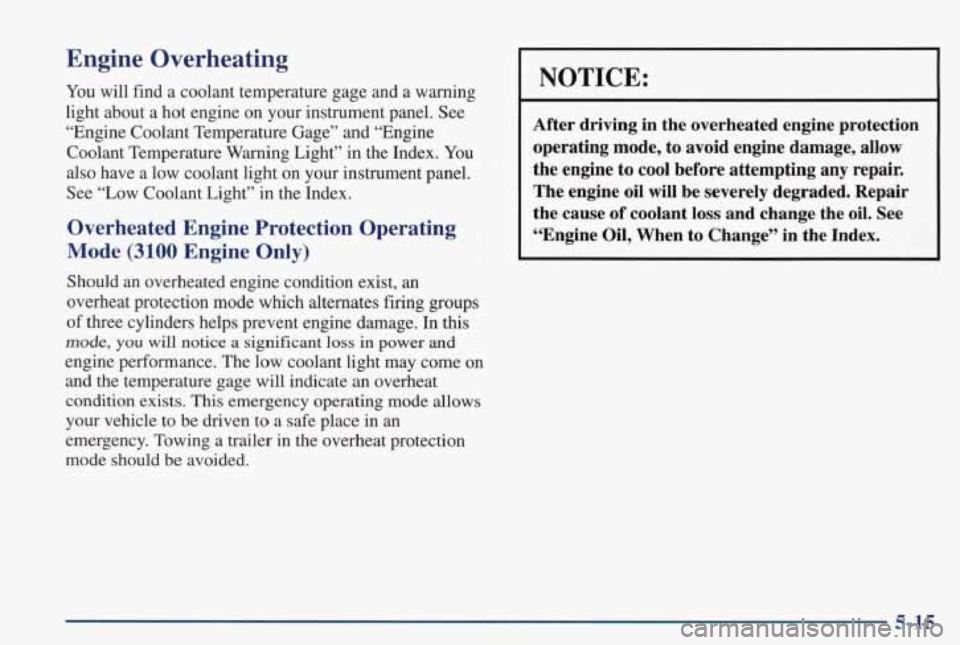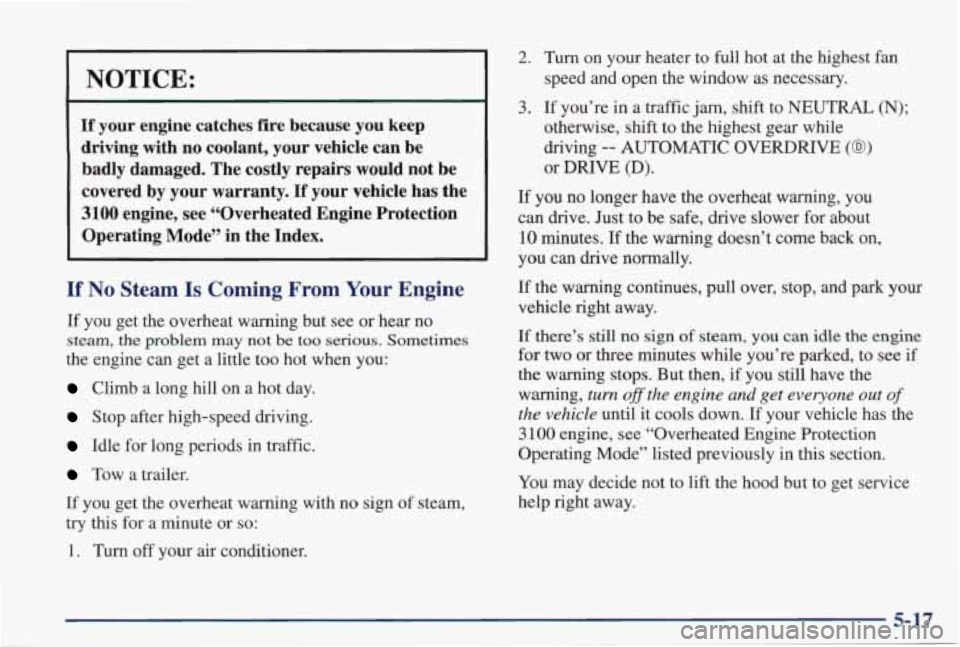Page 236 of 402
V
f Section 5 Problems on the Road
- ~~ ~~ - , I . . . . , .. - .~ . 1,F. - 1'7. -A,,. ,- , .. 5' _I ,_. . .- , ~ . .= . .-+ .. -. .. ,. .
Here you'll find what to do about some problems that can occur on the road.
5-2
5-2
5-3
5-8
5-15
Hazard Warning Flashers
Other Warning Devices
Jump Starting
Towing Your Vehicle
Engine Overheating
5 -26
5-27
5-37
5-38
If A Tire Goes Flat
Changing a Flat Tire
Compact Spare Tire
If You're Stuck: In Sand, Mud,
Ice
or Snow
5-1
Page 239 of 402

2. Get the vehicles close enough so the jumper cables
can reach, but be sure the vehicles aren’t touching
each other. If they are, it could cause a ground
connection you don’t want. You wouldn’t be able to
start your vehicle, and the bad grounding could
damage the electrical systems.
Put
an automatic transaxle in PARK (P) or a manual
transaxle in
NEUTRAL (N).
3. Turn off the ignition on both vehicles. Turn off all
lamps that aren’t needed, and radios. This will avoid
sparks and help save both batteries. And it could
save your radio!
I NOTICE:
r
~
If you leave your radio on, it could be badly
damaged. The repairs wouldn’t be covered by
your warranty.
’ /1 CAU-ION:
An electric fan can start up even when the engine
is not running and can injure you. Keep hands,
clothing and tools away from any underhood
electric fan.
4. Find the positive (+) and negative (-) terminals on
each battery. Your vehicle has a remote positive (+)
jump starting terminal. The terminal is on the same
side of the engine compartment as your battery. You
should always use the remote positive
(+) terminal
instead of the positive (+) terminal on your battery.
5-4
Page 241 of 402
5. Check that the jumper cables don’t have loose or
missing insulation.
If they do, you could get a shock.
The vehicles could be damaged, too.
I
CAUTION: 4
Before you connect the cables, here are some basic
things you should
know. Positive (+) will go to
positive (+) and negative (-) will go to negative (-)
or a metal engine part. Don’t connect positive (+) to
negative
(-), or you’ll get a short that would damage
the battery and maybe other
parts, too.
1
Fans or other moving engine parts can injure you
badly. Keep
your hands away from moving parts
once the engine
is running.
6. Connect the red positive (+) cable to the positive (+)
terminal of the vehicle with the dead battery. Use a
remote positive
(+) terminal if the vehicle has one.
Page 242 of 402
7. Don't let the other end
touch metal.
Connect it
to the positive
(+)
terminal of the good
battery. Use a remote
positive
(+) terminal if
ihe vehicle- has one.
1 8. Now connect the black
negative
(-) cable to
the good battery's
negative
(-) terminal.
Don't let the other end touch anything until the
next step. The other end
of the negative (-) cable
doesn 'Z go to the
dead battery.
I
It goes to a heavy, unpainted, metal part on the engine of
the vehicle with the dead battery.
9. Attach the cable at least 18 inches (45 cm) away
from the dead battery, but
not near engine parts that
move. The electrical connection
is just as good
there, but the chance of sparks getting back to the
battery is much less.
10. Now start the vehicle with the good battery and run
11. Try to start the vehicle with the dead battery.
the engine for a while.
If it won't start after a
few tries, it probably
needs service.
5-7
Page 243 of 402
12. Remove the cables in reverse order to prevent
electrical shorting. Take care that they don’t touch
each
other or any other metal.
nlo I
A. Heavy Metal Engine Part
B. Good Battery
C. Dead Battery
Towing Your Vehicle
Try to have a GM dealer or a professional towing
service tow your vehicle.
See “Roadside Assistance” in
the Index.
If your vehicle has been changed or modified since it
was factory-new by adding aftermarket items like fog
lamps, aero skirting,
or special tires and wheels, these
instructions and illustrations may not be correct.
Before you do anything, turn on the hazard
warning flashers.
When you call, tell the towing service:
0 That your vehicle cannot be towed from the front
0 That your vehicle has front-wheel drive.
The make, model and year of your vehicle.
0 Whether you can still move the shift lever.
0 If there was an accident, what was damaged.
with sling-type equipment.
5-8
Page 250 of 402

Engine Overheating
You will find a coolant temperature gage and a warning
light about a hot engine on your instrument panel. See
“Engine Coolant Temperature Gage” and “Engine
Coolant Temperature Warning Light” in the Index. You
also have a low coolant light on your instrument panel.
See “Low Coolant Light” in the Index.
Overheated Engine Protection Operating
Mode
(3100 Engine Only)
Should an overheated engine condition exist, an
overheat protection mode which alternates firing groups
of three cylinders helps prevent engine damage. In this
mode, you will notice a significant loss in power and
engine performance. The low coolant light may come on
and the temperature gage will indicate an overheat
condition exists. This emergency operating mode allows
your vehicle to be driven to a safe place in an
emergency. Towing a trailer in the overheat protection
mode should
be avoided.
NOTICE:
After driving in the overheated engine protection
operating mode, to avoid engine damage,
allow
the engine to cool before attempting any repair.
The engine
oil will be severely degraded. Repair
the cause of coolant loss and change the oil. See
“Engine Oil, When to Change” in the Index.
5-15
Page 251 of 402
If Steam Is Coming From Your Engine
A CAUTION:
-
Steam from an overheated engine can burn you
badly, even if you just open the hood. Stay away
from the engine
if you see or hear steam coming
from
it. Just turn it off and get everyone away
from the vehicle until it cools down. Wait until
there
is no sign of steam or coolant before you
open the hood.
If you keep driving when your engine is
overheated, the liquids in
it can catch fire. You or
others could be badly burned. Stop your engine if
it overheats, and get out of the vehicle until the
engine is cool.
5-16
Page 252 of 402

NOTICE:
If your engine catches fire because you keep
driving with no coolant, your vehicle can be
badly damaged. The costly repairs would not be
covered by your warranty.
If your vehicle has the
3100 engine, see “Overheated Engine Protection
Operating Mode” in the Index.
If No Steam Is Coming From Your Engine
If you get the overheat warning but see or hear no
steam, the problem may not be too serious. Sometimes
the engine can get a little too hot when you:
Climb a long hill on a hot day.
Stop after high-speed driving.
Idle for long periods in traffic.
Tow a trailer.
If you get the overheat warning with no sign of steam,
try this for a minute or so:
1. Turn off your air conditioner.
2. Turn on your heater to full hot at the highest fan
speed and open the window as necessary.
3. If you’re in a traffic jam, shift to NEUTRAL (N);
otherwise, shift to the highest gear while
driving
-- AUTOMATIC OVERDRIVE (03)
or DRIVE (D).
If you no longer have the overheat warning, you
can
drive. Just to be safe, drive slower for about
10 minutes. If the warning doesn’t come back on,
you can
drive normally.
If the warning continues, pull over, stop, and park
your
vehicle right away.
If there’s still no sign of steam, you can idle the engine
for two or three minutes while you’re parked, to see if
the warning stops. But then, if you still have the
warning,
turn off the engine and get everyone out of
the vehicle until it cools down. If your vehicle has the
3 100 engine, see “Overheated Engine Protection
Operating Mode” listed previously in this section.
You may decide not to lift the hood but to get service
help right away.
5-17